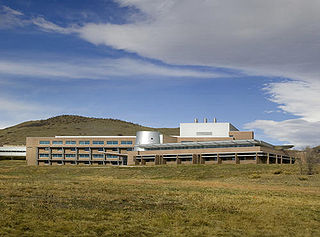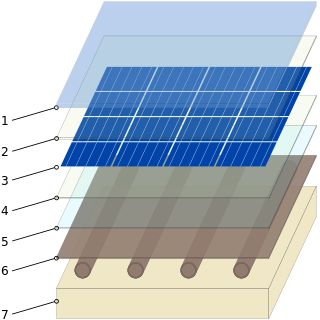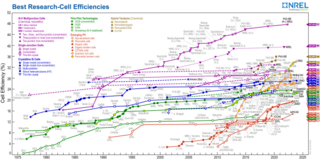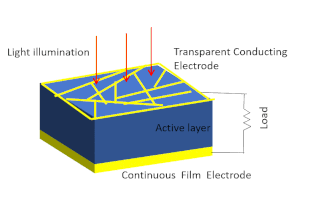This article needs additional citations for verification .(May 2012) |

Photovoltaic and renewable energy engineering is an area of research, development, and demonstration in Australia. Two Australian Research Council Centres play a role.
This article needs additional citations for verification .(May 2012) |

Photovoltaic and renewable energy engineering is an area of research, development, and demonstration in Australia. Two Australian Research Council Centres play a role.
The School of Photovoltaic and Renewable Energy Engineering at the University of NSW offers undergraduate training and postgraduate and research training opportunities in the area of photovoltaics and solar energy. It is widely recognised for its research in the area of photovoltaics, most of which is now conducted under the ARC Centre of Excellence for Advanced Silicon Photovoltaics and Photonics. [1]
The School of Engineering and Energy at Murdoch University offers a degree programs in physics, nanotechnology, engineering and energy. [2]
The ARC Centre of Excellence for Advanced Silicon Photovoltaics and Photonics opened on 13 June 2003. The Centre is engaged in silicon photovoltaic research and applying these advances to the related field of photonics. The Centre is made up of five research teams seeking ways of improving the efficiency and cost of silicon based photovoltaic and photonic devices. [3]
| PERL Solar Cell | Passivated emitter rear locally diffused (PERL) solar cell developed at UNSW. |
| Semiconductor Fingers | Semiconductor finger technology was developed at UNSW. Fingers of heavily doped semiconductor running parallel to front surface electrical contacts reduce the effect of the dead layer of commercial solar cells. |
| CSG | Crystalline silicon on glass (CSG) solar cells developed at UNSW are thin-film silicon devices directly onto glass. The technology is now in commercial production in Germany being produced by CSG Solar AG. |
The focus for the ARC Centre of Excellence for Solar Energy Systems is the development of improved silicon concentrator solar cells for 10-50 sun linear concentrators. Centre activities are located at the Centre for Sustainable Energy Systems in the Faculty of Engineering and Information Technology at the Australian National University. The Director of the ARC Centre for Solar Energy Systems is Professor Andrew Blakers and the Deputy Director is Dr Vernie Everett. [4]
| SLIVER Cell (TM) | Using a fraction of the costly and limited supply of silicon used in conventional solar panels while matching power, performance, and efficiency. [5] Professor Andrew Blakers, Director of the Australian National University Centre for Sustainable Energy Systems, invented the technology with colleague Dr Klaus Weber and developed it with funding from energy supplier Origin Energy and the Australian Research Council. Blakers and Weber won the Australian Institute of Physics' Walsh Medal for their work. [6] Origin Energy is developing SLIVER modules for commercialisation at its pilot plant in Regency Park, South Australia.[ citation needed ] |
| Dye Sensitised | Dye Sensitised cells are photoelectrochemical solar cells. Manufacturing techniques developed at ANU lead to commercialisation of the technology at Dyesol in Queanbeyan, NSW. |
A sound barrier composed of solar panels helps light a section of the Tullamarine Calder Interchange in northern Melbourne and received an award. [7]

Photovoltaics (PV) is the conversion of light into electricity using semiconducting materials that exhibit the photovoltaic effect, a phenomenon studied in physics, photochemistry, and electrochemistry. The photovoltaic effect is commercially used for electricity generation and as photosensors.

The National Renewable Energy Laboratory (NREL) in the US specializes in the research and development of renewable energy, energy efficiency, energy systems integration, and sustainable transportation. NREL is a federally funded research and development center sponsored by the Department of Energy and operated by the Alliance for Sustainable Energy, a joint venture between MRIGlobal and Battelle. Located in Golden, Colorado, NREL is home to the National Center for Photovoltaics, the National Bioenergy Center, and the National Wind Technology Center.
In the 19th century, it was observed that the sunlight striking certain materials generates detectable electric current – the photoelectric effect. This discovery laid the foundation for solar cells. Solar cells have gone on to be used in many applications. They have historically been used in situations where electrical power from the grid was unavailable.

A solar cell or photovoltaic cell is an electronic device that converts the energy of light directly into electricity by means of the photovoltaic effect. It is a form of photoelectric cell, a device whose electrical characteristics vary when it is exposed to light. Individual solar cell devices are often the electrical building blocks of photovoltaic modules, known colloquially as "solar panels". Almost all commercial PV cells consist of crystalline silicon, with a market share of 95%. Cadmium telluride thin-film solar cells account for the remainder. The common single-junction silicon solar cell can produce a maximum open-circuit voltage of approximately 0.5 to 0.6 volts.

A solar panel is a device that converts sunlight into electricity by using photovoltaic (PV) cells. PV cells are made of materials that produce excited electrons when exposed to light. The electrons flow through a circuit and produce direct current (DC) electricity, which can be used to power various devices or be stored in batteries. Solar panels are also known as solar cell panels, solar electric panels, or PV modules.

Martin Andrew Green is an Australian engineer and professor at the University of New South Wales who works on solar energy. He was awarded the 2021 Japan Prize for his achievements in the "Development of High-Efficiency Silicon Photovoltaic Devices". He is editor-in-chief of the academic journal Progress in Photovoltaics.
Third-generation photovoltaic cells are solar cells that are potentially able to overcome the Shockley–Queisser limit of 31–41% power efficiency for single bandgap solar cells. This includes a range of alternatives to cells made of semiconducting p-n junctions and thin film cells. Common third-generation systems include multi-layer ("tandem") cells made of amorphous silicon or gallium arsenide, while more theoretical developments include frequency conversion,, hot-carrier effects and other multiple-carrier ejection techniques.

Solar power, also known as solar electricity, is the conversion of energy from sunlight into electricity, either directly using photovoltaics (PV) or indirectly using concentrated solar power. Solar panels use the photovoltaic effect to convert light into an electric current. Concentrated solar power systems use lenses or mirrors and solar tracking systems to focus a large area of sunlight to a hot spot, often to drive a steam turbine.
A photovoltaic system, also called a PV system or solar power system, is an electric power system designed to supply usable solar power by means of photovoltaics. It consists of an arrangement of several components, including solar panels to absorb and convert sunlight into electricity, a solar inverter to convert the output from direct to alternating current, as well as mounting, cabling, and other electrical accessories to set up a working system. Many utility-scale PV systems use tracking systems that follow the sun's daily path across the sky to generate more electricity than fixed-mounted systems.
Stuart Wenham was, at the time of his death, the director of the ARC Centre of Excellence in Advanced Silicon Photovoltaics and Photonics and Director of Academic Studies of the School of Photovoltaic and Renewable Energy Engineering at the University of New South Wales.

Cadmium telluride (CdTe) photovoltaics is a photovoltaic (PV) technology based on the use of cadmium telluride in a thin semiconductor layer designed to absorb and convert sunlight into electricity. Cadmium telluride PV is the only thin film technology with lower costs than conventional solar cells made of crystalline silicon in multi-kilowatt systems.

Thin-film solar cells are made by depositing one or more thin layers of photovoltaic material onto a substrate, such as glass, plastic or metal. Thin-film solar cells are typically a few nanometers (nm) to a few microns (µm) thick–much thinner than the wafers used in conventional crystalline silicon (c-Si) based solar cells, which can be up to 200 µm thick. Thin-film solar cells are commercially used in several technologies, including cadmium telluride (CdTe), copper indium gallium diselenide (CIGS), and amorphous thin-film silicon.

Photovoltaic thermal collectors, typically abbreviated as PVT collectors and also known as hybrid solar collectors, photovoltaic thermal solar collectors, PV/T collectors or solar cogeneration systems, are power generation technologies that convert solar radiation into usable thermal and electrical energy. PVT collectors combine photovoltaic solar cells, which convert sunlight into electricity, with a solar thermal collector, which transfers the otherwise unused waste heat from the PV module to a heat transfer fluid. By combining electricity and heat generation within the same component, these technologies can reach a higher overall efficiency than solar photovoltaic (PV) or solar thermal (T) alone.
Narec, since 2014 known as the National Renewable Energy Centre, is a part of the Offshore Renewable Energy (ORE) Catapult, a British technology innovation and research centre for offshore wind power, wave energy, tidal energy and low carbon technologies. ORE Catapult's head office is in Glasgow, Scotland. The centre operates multi-purpose offshore renewable energy test and demonstration facilities. It is similar to other centres, such as NREL in the US and National Centre for Renewable Energies (CENER) in Spain. The National Renewable Energy Centre is based in Blyth, Northumberland.

Concentrator photovoltaics (CPV) is a photovoltaic technology that generates electricity from sunlight. Unlike conventional photovoltaic systems, it uses lenses or curved mirrors to focus sunlight onto small, highly efficient, multi-junction (MJ) solar cells. In addition, CPV systems often use solar trackers and sometimes a cooling system to further increase their efficiency.

There are currently many research groups active in the field of photovoltaics in universities and research institutions around the world. This research can be categorized into three areas: making current technology solar cells cheaper and/or more efficient to effectively compete with other energy sources; developing new technologies based on new solar cell architectural designs; and developing new materials to serve as more efficient energy converters from light energy into electric current or light absorbers and charge carriers.

Solar-cell efficiency refers to the portion of energy in the form of sunlight that can be converted via photovoltaics into electricity by the solar cell.
Amonix, Inc. was a solar power system developer based in Seal Beach, California. The company manufactured concentrator photovoltaic (CPV) products designed for installation in sunny and dry climates. CPV products convert sunlight into electrical energy in the same way that conventional solar photovoltaic technology does, except that they use optics to focus the solar radiation before the light is absorbed by solar cells. According to a comparative study of energy production of solar technologies, CPV systems require no water for energy production and produce more energy per megawatt (MW) installed than traditional PV systems. Amonix had nearly 70 megawatts of CPV solar power systems deployed globally, including Southwestern U.S. and Spain.

Antonio Luque López is a Spanish scientist and entrepreneur in the field of photovoltaic solar energy. In 1979 he founded the Institute of Solar Energy of the Technical University of Madrid (IES-UPM) and was its director till his retirement in 2017; he is currently its honorary president as well as professor emeritus in this university. He invented the bifacial solar cell in the late 1970s, today one of the mainstream solar cell technologies, and founded Isofoton in 1981 for its industrial production. He is, arguably, one of the fathers of the science and technology of concentrator photovoltaics and has been active in the research and development of high-efficiency photovoltaic conversion devices, inventing the intermediate band solar cell.
The Fraunhofer Institute for Solar Energy Systems ISE is an institute of the Fraunhofer-Gesellschaft. Located in Freiburg, Germany, The Institute performs applied scientific and engineering research and development for all areas of solar energy. Fraunhofer ISE has three external branches in Germany which carry out work on solar cell and semiconductor material development: the Laboratory and Service Center (LSC) in Gelsenkirchen, the Technology Center of Semiconductor Materials (THM) in Freiberg, and the Fraunhofer Center for Silicon Photovoltaics (CSP) in Halle. From 2006 to 2016 Eicke Weber was the director of Fraunhofer ISE. With over 1,100 employees, Fraunhofer ISE is the largest institute for applied solar energy research in Europe. The 2012 Operational Budget including investments was 74.3 million euro.